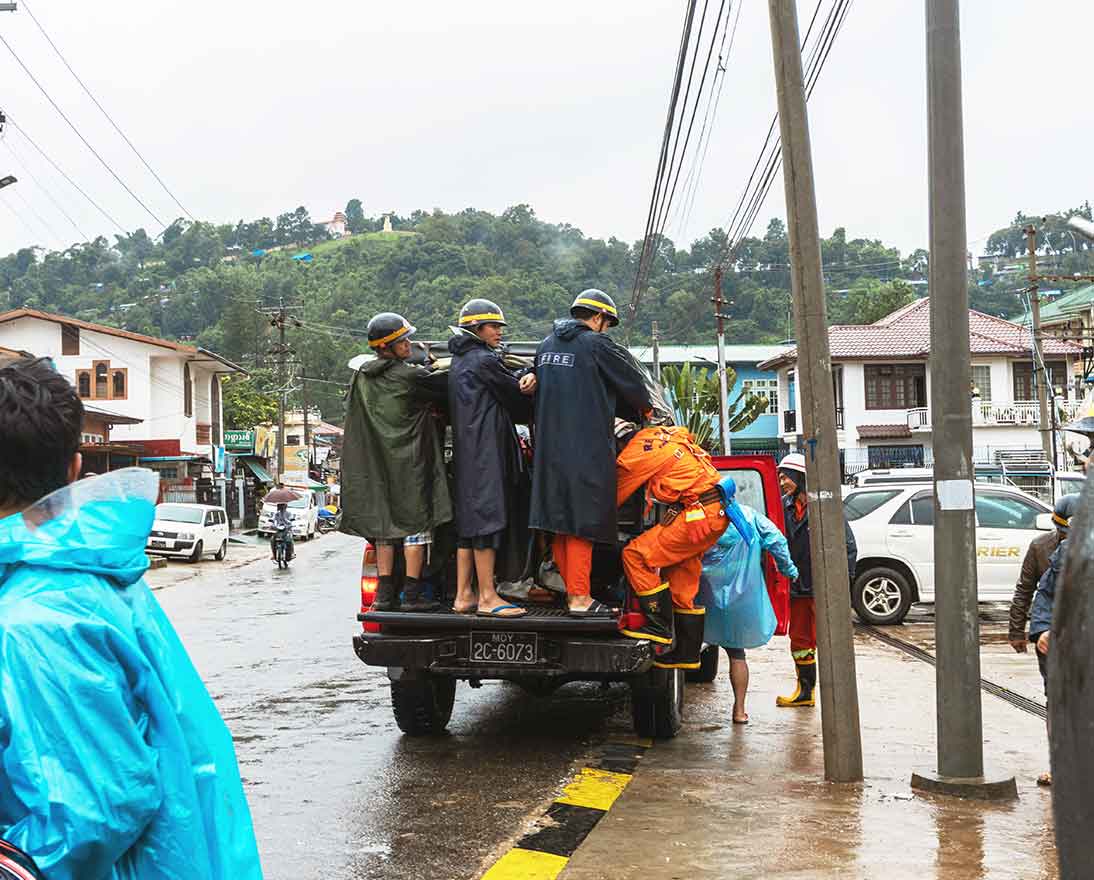The risks of rapid urbanization in developing countries
Global risksArticleApril 13, 2023
The movement of people from rural areas to live in towns and cities is one of the most significant population trends of modern times. However, rapid urbanization creates risks as well as opportunities – especially in developing countries.
For most of human history, the vast majority of people lived in relatively small groups in rural areas. The movement of populations away from the countryside to live in towns and cities over recent centuries – a process known as urbanization – is a relatively new phenomenon.
Today, more than half the world’s population (56.2 percent) live in cities. This trend toward greater urbanization can be seen in all regions of the world but is most pronounced in Latin America and the Caribbean, where more than 80 percent of the population now live in urban areas. Urbanization looks set to continue to follow this upward curve, with the United Nations predicting that 68 percent of the global population will live in urban areas by 2050.
The many benefits of cities are widely recognized, not least by the people who move to and live in them. The fable of Dick Whittington, who sought streets “paved with gold” in medieval London, has modern echoes all over the world. Well-managed cities are both productive and efficient, creating economies of scale and network effects. Lots of different people living close together can spark fresh ideas and creativity, which in turn leads to greater innovation and new employment opportunities.
The four big risks of urbanization
But it is important to acknowledge that rapid and often unplanned urbanization can also bring profound risks, especially in developing countries. These urbanization risks include increased social instability, threats to critical infrastructure, potential shortages of water and other vital resources, and the potential for the devastating spread of disease – as the COVID-19 pandemic has underlined. And as the unprecedented transition of human populations from rural to urban areas continues to expand in scope and scale, so do the associated risks.
In too many cases, unchecked urbanization goes hand in hand with widespread poverty. Estimates suggest that just under 1-in-3 people in urban areas live in slum households.
This article examines four key areas of urbanization risk and how they can be affected by rapid urbanization in developing countries: infrastructure, health, climate change and social instability. Within each area we also highlight new or increased risks that are possible to manage or, in some cases, transfer through the mechanism of insurance.
1. Infrastructure
The quality of a city’s infrastructure is central to its residents’ quality of life, economic opportunities and feeling of social inclusion. Airports, road networks and rail systems; schools and hospitals; water utilities, power and telecommunications grids. Infrastructure is the lifeblood for all cities.
It also helps determine a city’s resilience to a number of global risks. These include environmental, social and health-related risks as well as economic risks, such as unemployment. The availability and quality of infrastructure is at the core of many of the challenges faced by rapidly urbanizing cities in developing countries, while underinvestment poses similar challenges in most developed economies too, where investment in upgrading or replacing old infrastructure is insufficient.
According to the World Economic Forum (WEF), almost 14 percent of global GDP is invested in infrastructure, with most of that divided across the following categories:
- Transportation infrastructure (roads, railroad, airports, ports)
- Electric power supply and distribution
- Water supply and sewage
- Communications infrastructure
However, thanks to the world’s growing population, increasing urbanization and economic development, the current levels of investment infrastructure are not enough. In fact, if current trends continue, the gap between projected infrastructure spending and the amount of investment needed to meet the world’s infrastructure needs is predicted to grow to USD 15 trillion by 2040.
Failures in infrastructure due to a lack of investment have significant implications for property and business continuity for city authorities, as well as central government bodies. There is a growing need to transform how infrastructure is planned, delivered and managed as urbanization, digitalization and climate change increasingly impact the world. Insurers can help by providing risk advice on infrastructure maintenance and also appropriate levels of coverage to insure for property damage and business interruption.
2. Health
Over the course of the last century, the health of people living in cities benefited from better access to education and healthcare, improved living conditions and targeted public-health interventions.
However, when urbanization is rapid and unplanned, a combination of high population density, aging populations, poverty and lack of infrastructure can have a negative impact on public health, primarily by fostering conditions in which communicable diseases can flourish.
Global health systems were weakened by the COVID-19 pandemic and now find themselves under continued pressure. This is due, in part, to people live longer and suffering illnesses associated with old age. There are also higher morbidity and mortality rates among socially disadvantaged, and often urban, communities. This erodes quality of care and shrinks access to healthcare, which is highlighted by the lack of hospital capacity during infectious disease outbreaks.
It is striking that, today, more than 700 million people who live in urban environments live without improved sanitation, which in turn contributes to poor health. The problem is particularly acute in Eastern and South-Eastern Asia (where more than 370 million people are living in slums), sub-Saharan Africa (more than 238 million) and Central and Southern Asia (more than 227 million). All of these urban populations are faced with increased levels of risk to illnesses, including worm infections, cholera and diarrhea. Looking ahead, an estimated 3 billion people will be in need of adequate and affordable housing by 2030.
Most worryingly, as cities expand and infringe on neighboring rural areas, there is increasing contact between wild animal populations and humans, increasing the risks of zoonotic disease transmission. Once infected, in today’s hyper-connected world, it is easier for pathogens to be carried between human urban populations and then from one city to another, with the potential for large-scale outbreaks, epidemics and – as we have seen with COVID-19 – global health emergencies.
3. Climate change
Rapid and poorly planned expansion of cities can also leave urban populations exposed to the effects of climate change. It is true that migration from rural areas to cities is at least partially motivated by the increasing prevalence of extreme weather and other environmental crises connected to climate change, such as flooding, wildfires, droughts and crop failures. However, although cities can provide a place of refuge in the short term, many of the world’s great cities are located on coastlines or on natural waterways, where they are at greater risk of flooding and storm surge.
Worryingly, there are 570 coastal cities – with a total population of over 800 million – that are considered vulnerable to a climate change-induced sea level rise of just 0.5 meters by 2050. Making cities more resilient to extreme weather events should therefore be a priority for both local governments and the private sector. The insurance industry can contribute in a variety of ways, including by offering risk management advice, products and services (such as property insurance) related to flood management.
City infrastructure needs to become smarter and more sustainable. There is a growing need to transform how infrastructure – and construction projects – are planned, delivered and managed as urbanization, digitalization and climate change increasingly impact the world. This includes integrating digital technologies with physical assets and using data to see and understand things that were previously too big or interconnected to make sense of.
“From an insurance perspective, the risks associated with the urban built environment need to be considered from the full life-cycle aspects of design, build, own, invest and operate that reflect the material carbon costs of build and recycling,” says John Scott, Head of Sustainability Risk at the Zurich Insurance Group. “This includes the data from the internet-of-things that connects sensors in real-time that support better maintenance and the impact of rapidly changing risk landscape of technology integration, such as solar roof panels and electric vehicle chargers.”
4. Social instability
The capacity of cities to generate wealth already largely determines global growth: although just over half the world’s population lives in cities, they generate more than 80 percent of global GDP. Ultimately, new migrants in cities are expected to earn more than they would in the countryside. This in turn has the potential to increase personal wealth and encourage city-dwellers to protect personal assets and income, offering another important supporting role for the insurance industry.
However, even when cities are well managed, the process of absorbing migrants into urban economies is not necessarily a smooth one. Higher costs of living and increased competition for jobs can also trap people in poverty.
Rapid and poorly planned urbanization can also quickly lead to increased violence, crime and social unrest. Widening inequalities tend to be more starkly visible in urban areas than rural ones. A combination of inequality, competition for scarce resources such as land, drug cartels and weak city governance can all stoke the problem. Some cities in developing countries are already extremely dangerous, experiencing annual murder rates of more than 100 deaths per 100,000 inhabitants.
Urbanization can also create social friction between different economic groups. For example, high population density can lead to property bubbles which enrich some while excluding others. This combination, especially when experienced by urban populations living in relatively close proximity, can increase social instability and destabilize the wider urban economy.
Risks and opportunities
Ultimately, urbanization creates opportunities – which is why people are motivated to move to cities and towns in the first place. But it also creates new risks and stokes existing ones as the speed at which urbanization is happening challenges cities’ capacity to plan and adapt. This is particularly true in developing economies.
For rapid urbanization to provide opportunities to all, carefully considered urban planning and good governance within effective regulatory frameworks are required. Indeed, the inability of governments to provide appropriate infrastructure and public services is at the core of many urban challenges in developing countries.
The strength of city-level institutions working in partnership with national institutions – their capacity to be flexible, innovative and dynamic, and effectively involve multiple stakeholders in governance – will largely determine whether urbanization makes the world more resilient or more vulnerable in the face of global risks.
As these risks are interconnected, a holistic approach is key to mitigating them. And as with all risk management, the first steps to take are awareness followed by discussion and collaboration. Close contact between business, governments, communities, city councils, and academic institutions is essential in reaching effective solutions, as this fosters an environment in which innovative and effective public-private partnerships can develop.
At Zurich, we see the big picture of interconnected risks and collaborate with those who care about them. Whether through the latest technological developments for smart traffic control or managing risks to critical infrastructure, it has never been so important to ensure that cities – and especially those in the developing world – are effectively managed and resilient, both now and in the future.



